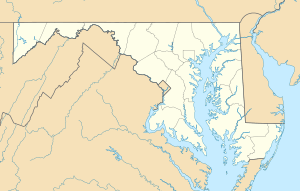Patuxent Research Refuge facts for kids
Quick facts for kids Patuxent Research Refuge |
|
|---|---|
|
IUCN Category IV (Habitat/Species Management Area)
|
|

National Wildlife Visitor Center
10901 Scarlet Tanager Loop Laurel, MD 20708 |
|
| Location | Anne Arundel County, Prince George's County, Maryland, United States |
| Nearest city | Laurel, Maryland |
| Area | 12,800 acres (52 km2) |
| Established | 1936 |
| Governing body | U.S. Fish and Wildlife Service |
| Website | Patuxent Research Refuge |
The Patuxent Research Refuge is a special place in Maryland, United States. It's a National Wildlife Refuge, which means it's a protected area for animals and plants. President Franklin D. Roosevelt created it in 1936.
This refuge is unique because it's the only one in the country made specifically for wildlife research. Scientists here study animals and their homes. The refuge started small but has grown to over 12,800 acres (about 52 square kilometers). It sits between the Patuxent River and Little Patuxent River, near Washington, D.C. and Baltimore, Maryland.
Contents
Discover Patuxent Research Refuge
The Patuxent Research Refuge is managed by the United States Fish and Wildlife Service. Its main goal is to protect wildlife and their natural homes. This is done through careful research and wildlife management.
What Makes Patuxent Special?
The refuge is home to many different kinds of plants and animals. It has forests, open meadows, and wetland areas. These different habitats help support a wide variety of life.
Plants of the Refuge
Over 1,100 types of plants have been found at Patuxent. These plants are important for the animals that live there. They provide food and shelter for many creatures.
Amazing Wildlife and Birds
Patuxent is a haven for wildlife. The land is managed to keep many different species healthy. It's especially important for native birds and those that travel long distances.
During spring and fall, many waterfowl (like ducks and geese) stop here. They rest and find food on their long journeys. More than 270 different kinds of birds have been seen at the refuge. You might even spot a majestic Bald eagle flying overhead!
The refuge is one of the largest forested areas in the mid-Atlantic region. This makes it a critical place for many birds to raise their young and spend the winter.
Exploring the Refuge: Visitor Areas
The Patuxent Research Refuge is divided into three main parts. Each part has a different purpose.
North Tract: Adventure Awaits
The North Tract is open to visitors who love the outdoors. Here, you can go hunting and fishing in certain areas. It also has trails for exploring and watching wildlife. Many fun and educational programs are offered here.
Central Tract: Science Headquarters
The Central Tract is where the main offices are located. This includes the headquarters for the refuge itself. It's also home to the USGS Patuxent Wildlife Research Center. This is where scientists do their important studies. This area is mostly for research and is not open to the public.
South Tract: Learning at the Visitor Center
The South Tract is home to the National Wildlife Visitor Center. This center is the largest place in the country for learning about environmental science. It's run by the United States Department of the Interior.
The Visitor Center has trails and many educational programs. It's a great place to learn about nature and conservation. Both the North Tract and the National Wildlife Visitor Center are open for you to visit and enjoy!
Images for kids




